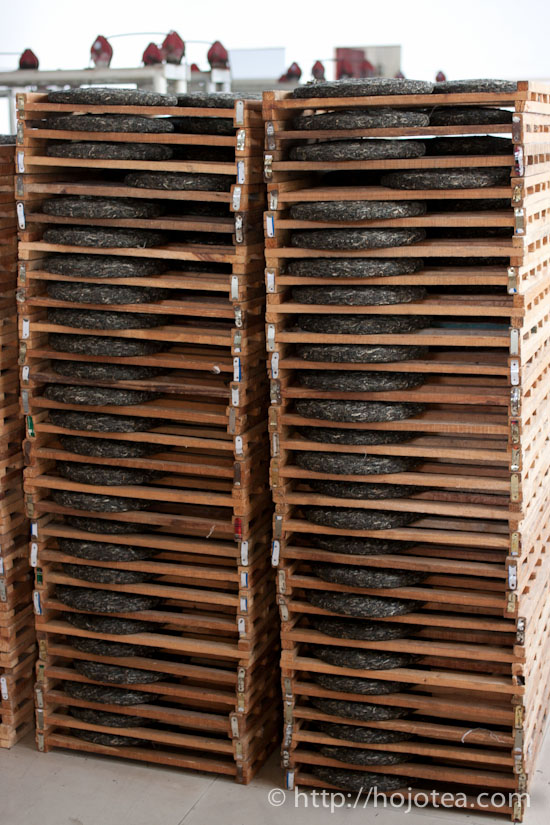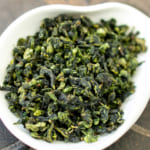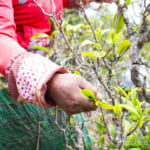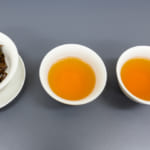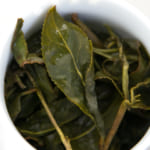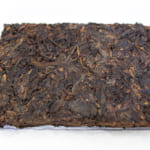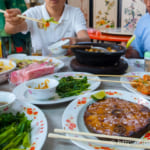- HOME >
- Types of Tea
The Beauty of Pu-erh Tea Mao-Cha
- [2014.03.18] Posted By Akira Hojo
During our purchasing of Pu-erh tea in Yunnan, we select the tea in mao-cha form. A mao-cha means loose tea right after the production. For more than a thousand years, tea compression was carried out, where the mao-cha is compressed into a round cake or rectangular brick shape.
There are 2 reasons why the pu-erh tea in Yunnan is compressed.
- The mao-cha is too bulky due to the low bulk density of the loose tea leaves. The compressed teas are much easier in handling during the long distance transportation.
- The hard compression will eliminate air from the tea leaves and allow them to achieve a vacuumed environment which would encourage the well maturation of tea.
I believe many people have not tried the mao-cha of raw pu-erh tea. The mao-cha is the loose form of the raw pu-erh tea leaves. In the production area of pu-erh tea in Yunnan, most people drink Pu-erh tea in mao-cha form. As the process of raw pu-erh tea is pretty close to that of green tea, the flavor of mao-cha is very floral with an up-lifting refreshing aroma, and this refreshing floral flavor is normally diminished once tea is steamed and compressed.
The comparison of the process between Green Tea and Raw Pu-erh tea.
Green Tea : Pan-Frying/Steaming > Rolling > Hot Air Drying
Pu-erh Raw Tea: Pan-Frying > Rolling > Sunshine Drying
If you have never tried the mao-cha of raw pu-erh tea, I would suggest you to try one of our line-ups called “Mei Lan”. The Mei Lan has a very distinctive citrus flavor that reminds us of the pomelo skin. Despite the tea is still very young, it gives a very strong flavor. Many customers who have tried this tea so far thought it was an oolong tea. The mao-cha is very flavorful and pleasant to enjoy.
For the process of tea compression, the first step is to apply steam to the dry tea leaves in order to soften them. Due to this step, the moisture will be trapped inside the tea leaves when compression is carried out. The compressed tea is just like a chunk of wet cloth crumbled tightly together. You could easily imagine how difficult it would be to get dried. Usually, it takes more than a week to eliminate moisture from the compressed tea cake/brick. Consequently, the tea leaves would be dam for more than a week; which is no doubt, the original flavor of mao-cha will disappear.
Due to this reason, many compressed Raw Pu-erh teas give a quite similar flavor despite each of them has its very distinctive flavor while they were in mao-cha form.
However, it is hard to decide if we should stop compressing tea. The compressed tea has an advantage as well, as it is more stable for maturation when the tea is not kept under perfect environment. Thanks to the absence of oxygen inside the cake, the maturation of tea is steadier. After storing the tea for another few years, the sweet flavor starts emerging back; it is due to the maturation of the tea.
Starting from 2013, we are wishing to bring in some raw pu-erh tea in mao-cha form. Based on our experience, we have confirmed that the mao-cha also undergoes maturation very well as long as we ensure that there is no oxygen inside the bag. This year, if we find any loose pu-erh tea that produces very distinctive and strong flavor, we are likely to bring it in mao-cha form, just like the Mei Lan 2013. If the flavor of mao-cha is not too strong or outstanding, we may consider compressing it as usual for further maturation.
Related Articles
How to get the latest update on HOJO Tea?
1. Follow Twitter, 2. Click "Like" on Facebook, and 3. Subscribe in newsletter. You can have the latest tea news from HOJO Tea.
 Subscribe the Newsletter to enjoy the privileges
Subscribe the Newsletter to enjoy the privileges- You may receive a free sample upon purchase, or you may have the priority to purchase special products. So please remember to subscribe our newsletter as well as the social network.
- New Release of Anxi Traditional Oolong
- Anxi, located in Fujian province, China, is celebrated for its Tie Guan Yin tea. However, the Traditional Anxi Oolong from this region boasts a unique fruity aroma, distinguishing it from Tie Guan Yin. Anxi: A Renowned Hub for Oolong Tea Production in China Fujian Province, renowned for its rich tea heritage, boasts several prominent tea-producing …
- New Release of Lan Yun Tie Guan Yin from Anxi
- Lan Yun Tie Guan Yin from Anxi, is not just an ordinary Tie Guan Yin. It has a strikingly delightful flavor reminiscent of orchid flowers with silky-soft drinking sensation. Anxi, renowned as one of the three major Oolong tea production regions in China. Anxi is recognized as one of the three major Oolong tea-producing regions …
NEW ARTICLES
 New Release of Anxi Traditional Oolong
New Release of Anxi Traditional Oolong- Anxi, located in Fujian province, China, is celebrated for its Tie Guan Yin tea. However, the Traditional Anxi Oolong from this region boasts a unique fruity aroma, distinguishing it from Tie Guan Yin. Anxi: A Renowned Hub for Oolong Tea Production in China Fujian Province, renowned for its rich tea heritage, boasts several prominent tea-producing …
 Yunnan 2024 Spring Tea Sourcing
Yunnan 2024 Spring Tea Sourcing- Yunnan Province is globally renowned for the exceptional quality of its tea leaves. However, lax production management often presents challenges in achieving the desired tea quality when relying solely on pre-made teas. To address this issue, we have committed to remaining on-site throughout the spring season to closely monitor tea production. We are meticulously inspecting …
 The Relationship Between Greenness of Tea Leaves and Fertilizer
The Relationship Between Greenness of Tea Leaves and Fertilizer- For both tea and vegetables, there’s a common misconception that a deeper green colour indicates better quality and greater health benefits. However, this isn’t always the case. Natural plants often have a yellowish-green hue rather than a vibrant green. If you observe wild plants in grasslands or along roadsides during spring, you’ll notice that they …
 Creating Muscatel Black Tea Using a Unique Blending Method
Creating Muscatel Black Tea Using a Unique Blending Method- I would like to introduce the unique creation of black tea with a distinctive muscatel flavor profile. Acquiring Exceptional Mi Xiang Black Tea Have you ever heard of a unique black tea called “Mi Xiang Black Tea” or “Muscatel Black Tea”? This tea is crafted from leaves that have been delicately nibbled by leafhoppers, resulting …
 New Release of Lan Yun Tie Guan Yin from Anxi
New Release of Lan Yun Tie Guan Yin from Anxi- Lan Yun Tie Guan Yin from Anxi, is not just an ordinary Tie Guan Yin. It has a strikingly delightful flavor reminiscent of orchid flowers with silky-soft drinking sensation. Anxi, renowned as one of the three major Oolong tea production regions in China. Anxi is recognized as one of the three major Oolong tea-producing regions …
 The Difference Between Fermentation in Tea and Fermented Foods
The Difference Between Fermentation in Tea and Fermented Foods- Black tea and oolong tea are often categorized as “fermented teas,” but the extent to which they undergo fermentation raises questions about whether they truly qualify as fermented foods. In this article, I endeavour to offer a thorough exploration of the distinctions between tea and traditional fermented foods, shedding light on the nuances of their …
 Easy Way to Prepare Flavorful and Warm Tea at the Workplace
Easy Way to Prepare Flavorful and Warm Tea at the Workplace- Have you ever experienced the transformation of tea stored in a thermos or water bottle at work, turning into a brown hue and acquiring a bitter, astringent taste? As this has piqued the interest of many, I would like to offer a more in-depth explanation for a solution. Tea stored in a thermos undergoes oxidation …
 The new release of Bao Dao Shan Da Cha Tou Brick 2017, exclusively crafted from Da Cha Tou leaves
The new release of Bao Dao Shan Da Cha Tou Brick 2017, exclusively crafted from Da Cha Tou leaves- Bao Dao Shan Cha Tou Zhuan 2017 is a ripe pu-erh tea crafted into brick form. Bao Dao Shan is the name of the mountain situated in the southwestern part of Yunnan. “Cha Tou” denotes a distinctive type of ripe pu-erh tea. In the course of fermenting spring tea, certain tea clumps naturally develop, known …
 We released Lapsang Suchong Qi Zhong Classic: Premium Lapsang Souchong
We released Lapsang Suchong Qi Zhong Classic: Premium Lapsang Souchong- Lapsang Souchong is one of the earliest known black teas distinguished by a unique production method and flavour profile. Its origins are often linked to the Wuyi Mountains in China’s Fujian province, where Lapsang Souchong is traditionally crafted. Black tea production in the Wuyi region has a history dating back several centuries. Lapsang Souchong tea …
 Regular Consumption of Umami Seasoning Can Influence Taste Preferences
Regular Consumption of Umami Seasoning Can Influence Taste Preferences- Excessive consumption of artificial condiments, such as umami seasonings, is believed to influence one’s taste and preferences. I’d like to share my own view to explore how an overabundance of condiments can indeed influence one’s palate. Umami Seasonings Are Prevalent in Asian Countries I spend half of the year living abroad, particularly in China and …
Shop Info

Address:Lot No. T-215, 3rd Floor, The Gardens Mall, Mid Valley City, Lingkaran Syed Putra, 59200 Kuala Lumpur
Tel: +603-2287-4537
Business Hour: 10am to 10pm
Category
- New Arrival at HOJO Online Shop
- Featured Articles
- Newsletter
- Types of Tea
- Origin of Tea
- Teapot and Tea Equipment
- Tea Column
- How to enjoy tea
- Tea Processing
- How to choose quality tea
- Tea constituents and functional effect
- Safety of Tea
- Foods
- Tea Business Operation
- Hobby and Outdoor Activity
- Ranking of Tea
- Video
- FAQ
- Media Release
Profile

- AKIRA HOJO
- I invite you to experience my tea selections.I was born in Nagano, Japan. In university, I studied agricultural chemistry, and I have the master degree in food science. I worked in Japanese food industry for 10 years. I involved in R&D, QC and QA. As a factory manager, I implemented ISO9000 series and managed the factory.
- The Art of Tea Magazine
- We posted the article on “The Art of Tea Magazine No.9, the magazine is published in Taiwan. We featured some scientific view about the tetsubin
- New Straits Times
- The Malaysian National Newspaper, New Straits Times featured HOJO Tea on 17-Oct-2007.



